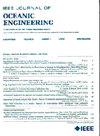一种新型复合转叶舵机消除转向系统力位耦合的可行性研究
IF 5.3
2区 工程技术
Q1 ENGINEERING, CIVIL
引用次数: 0
摘要
针对舵机转向过程中舵叶与水动力之间存在强力-位置耦合的问题,设计了一种新型复合旋叶舵机执行机构。执行器通过转矩解耦缸对舵驱动缸施加主动转矩,从而消除液压力对舵驱动缸产生的负载转矩。仿真和实验结果表明,与单层转叶舵机相比,复合转叶舵机在水动力载荷作用下具有更快的转向速度、更高的定位精度和更强的抗扰能力。在水动载荷扰动下,复合叶片舵机达到稳态的平均时间缩短了37.45%,稳态误差小于0.1°。当遇到冲击荷载时,平均稳定时间缩短41.45%,验证了结构消除荷载的原理。复合转叶舵机在大惯性、强非线性的转向系统中表现出优异的操纵性能。本文章由计算机程序翻译,如有差异,请以英文原文为准。
Feasibility Study on the Elimination of Force-Position Coupling in Steering Systems With a Novel Compound Rotary Vane Steering Gear
In this article, a novel compound rotary vane steering gear actuator was designed to solve the problem of strong force-position coupling between the rudder blade and hydrodynamic force during the steering process. The actuator applies active torque to the rudder drive cylinder through a torque decoupling cylinder, so as to eliminate the load torque generated by the hydraulic force on the rudder drive cylinder. The simulation and experiment results show that compared with a single-layer rotary vane steering gear, the compound rotary vane steering gear has faster steering speed, higher position accuracy, and stronger disturbance rejection capability under the influence of hydrodynamic loads. Under disturbances of hydrodynamic load, the average time for the compound rotary vane steering gear to reach steady state is reduced by 37.45%, and the steady-state error is less than 0.1°. When the impact load is encountered, the average stability time is reduced by 41.45%, thus verifying the principle of eliminating load by structure. The compound rotary vane steering gear demonstrated excellent maneuvering performance when applied to steering systems with large inertia and strong nonlinearity.
求助全文
通过发布文献求助,成功后即可免费获取论文全文。
去求助
来源期刊

IEEE Journal of Oceanic Engineering
工程技术-工程:大洋
CiteScore
9.60
自引率
12.20%
发文量
86
审稿时长
12 months
期刊介绍:
The IEEE Journal of Oceanic Engineering (ISSN 0364-9059) is the online-only quarterly publication of the IEEE Oceanic Engineering Society (IEEE OES). The scope of the Journal is the field of interest of the IEEE OES, which encompasses all aspects of science, engineering, and technology that address research, development, and operations pertaining to all bodies of water. This includes the creation of new capabilities and technologies from concept design through prototypes, testing, and operational systems to sense, explore, understand, develop, use, and responsibly manage natural resources.
 求助内容:
求助内容: 应助结果提醒方式:
应助结果提醒方式:


